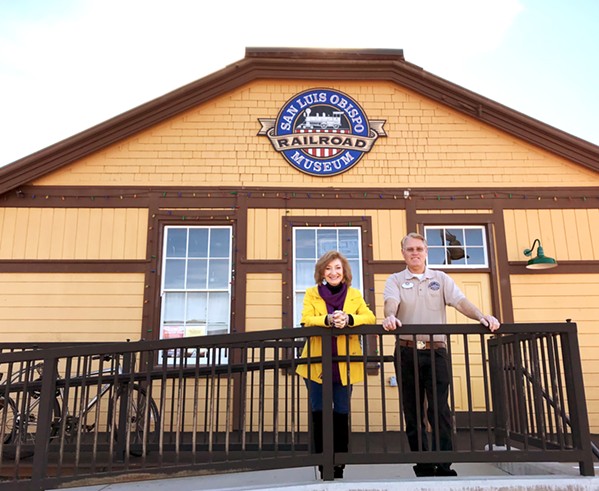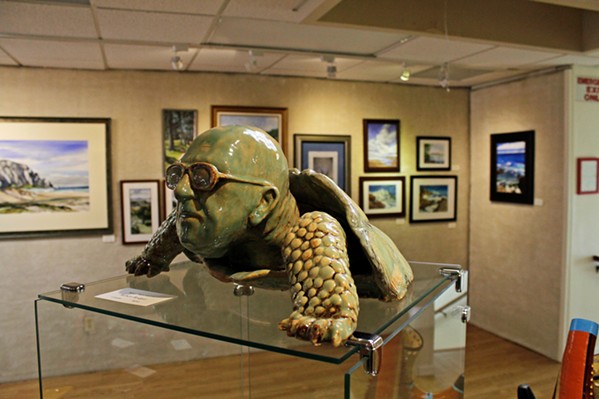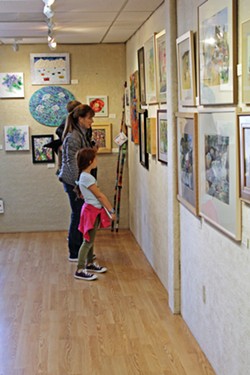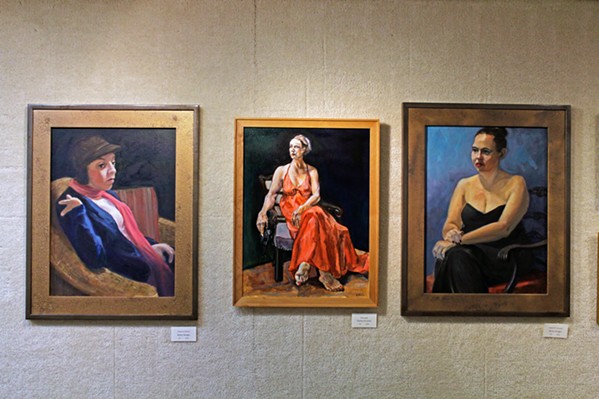
Welcome to 2020! It's always at the beginning of the year that New Times shows its appreciation to the volunteers who give their time working for something they are passionate about. In this year's Volunteers Issue, Assistant Editor Peter Johnson talks to the folks who dreamed up the SLO Railroad Museum and brought history to life, Staff Writer Karen Garcia focuses on Paso Robles youth who honor veterans through Wreaths Across America, and Staff Writer Kasey Bubnash writes about the Morro Bay Art Association's newest event.
—Camillia Lanham

- Photos By Peter Johnson
- PRESERVING HISTORY SLO Railroad Museum Manager Diane Marchetti (left) and President Brad LaRose work daily to keep Central Coast railroad history alive.
All aboard: The SLO Railroad Museum is still finding new ways to bring history to life
Stepping into the San Luis Obispo Railroad Museum takes you back in time.
The restored freight house, built in 1894 by Southern Pacific Railroad, doesn't look like much of a relic from the outside. But inside, an authentic historical experience comes to life.
The freight house's barn-like ceiling creates a drafty and rustic atmosphere. The space—formerly a hub for loading and transferring goods by rail across the region and beyond—is now occupied by thoughtfully arranged exhibits displaying various railroad artifacts. There are furnishings, like an original freight house agent's desk; pieces of train equipment, like a mine ore car; plenty of photographs, maps, and information plaques; and much more.
It's a time capsule dedicated to a unique and vital part of Central Coast history.
"We're the only one doing this in this region," said Brad LaRose, president of the museum.
Decades of dreaming, planning, and artifact collecting among local railroad enthusiasts finally paid off when this museum first opened its doors in 2013. While the museum has existed in concept since 1991, it struggled for years to find a permanent home.

- Photos By Peter Johnson
- MODEL A model railway sits in the SLO Railroad Museum. Pictured is the train station in SLO—note Bishop Peak and Cerro San Luis in the background.
"It was a museum without a physical location," explained Diane Marchetti, the museum manager. "Guys like Brad [LaRose] and some of our other members were, for many years, acquiring artifacts because in their minds someday there was going to be a physical location. And it came to pass."
That opportunity came in the 2000s when the city of SLO agreed to lease the building to the museum, as it had purchased the property for more Amtrak parking and was looking to revitalize the area.
"This was blighted; this should have been burnt down accidentally many times and didn't," LaRose said of the freight house. "The city didn't know what to do with it."
LaRose, one of the nonprofit's founding members in '91, has traveled from coast to coast—literally—to retrieve artifacts that are now on display at the museum. Found anywhere and everywhere, he said, many items were collected long before there was a museum to put them in.
"There's a guy who lived 300 feet from here who brought an artifact to us," LaRose said. "And, on the other hand, I've driven all the way to Baltimore, Maryland, just to pick up a bell and a whistle."
What's in the museum now is all thanks to the tireless efforts of a few dozen dedicated volunteers—and, of course, generous donors.
LaRose noted that all of the artifacts were carefully selected to be authentic to local history—to the Central Coast railroad industry that was the region's economic engine in the 19th and 20th centuries. Before highways and commercial trucks, goods, food, and people moved by rail, not just on the Southern Pacific line that traversed the West Coast, but on forgotten local networks like the Pacific Coast Railway (which connected Avila Beach to SLO) and the Santa Maria Valley Railroad. Even individual farmers made their own makeshift railways, installing temporary lines in their orchards, for example, to easily transport harvests.
Practically everything was done by rail—first via steam engine trains and later electric and diesel locomotives—until Southern Pacific shut down for good in 1996. It's an era of history that fascinates the volunteers who contribute to its preservation.
They contribute in different ways, too. Volunteer John Marchetti, for instance, is the mastermind behind the museum's spectacular model railroad, which is tucked in a back room of the freight house. John (who's married to Diane) said he first started constructing the model at home back in the 1950s. Now, it's on display at the museum—the incredibly detailed tracks, trains, and stations backdropped by colorful depictions of the landscape that show exactly where along the route the model is.
"There's Paso Robles; it goes down the grade and works its way around," John explained as he showed the model. "That's the building you're in right there."
The model, which winds all around the room, represents years and years of painstaking work.
"It takes so many hours to produce just even one of these tiny buildings," Diane noted.
Outside the museum, on a stretch of tracks that run parallel to it, several old train cars are also on display. Among them are an old caboose, a steel gondola used in the sugar beet trade, and an Army locomotive used during World War II at Camp Roberts.
Restoring these cars is LaRose's passion. With help from a crew of volunteers, LaRose consults old photographs, books, and blueprints to bring these artifacts back to a vibrant and authentic state.
His latest challenge is to restore a classic Southern Pacific boxcar—the last of its kind still around. Bill Walther, a retired Southern Pacific employee, made a donation to help the museum turn the old boxcar into an exhibit, which will house a theater and a photographic display dedicated to the thousands of locals who worked in the industry—some of whom died on the job.
Walther told New Times he wanted to pay tribute to all of the locomotive engineers who put their lives at risk working in the dangerous but important business. Having retired early due to a debilitating accident, Walther felt compelled to honor his peers who helped support his retirement. Recently, the last surviving steam locomotive engineer on the Central Coast, David "Duke" Duceshi, passed away, marking the symbolic death of that generation.
"I just think it's important to recognize the contribution that the railroad has done for SLO County over the years; it seems it's almost gone now," Walther said. "We need to recognize what it was."
For every facet of the SLO Railroad Museum, LaRose said, volunteers are needed and welcomed. From archival work in its library to restoration work on the train cars, the museum's leaders want the community to get involved.
"We all have something to contribute," he said. Δ
Learn local history: The San Luis Obispo Railroad Museum is located at 1940 Santa Barbara Ave., SLO, and is open to the public on Saturdays from 10 a.m. to 4 p.m. Admission for non-member adults is $5 ($3 for children). To learn more about the museum and how to volunteer, donate, or become a member, visit slorrm.com.
Assistant Editor Peter Johnson can be reached at [email protected].
During the holiday season, a local Air Force-focused nonprofit pays respect to veterans laid to rest

- Photo Courtesy Of Coni Wells
- APPRECIATION During a Dec. 14 ceremony, Coni Wells watched her 13-year-old son Colton place wreaths on graves and salute veterans who were laid to rest in the Paso Robles District Cemetery.
On this past Dec. 14, 25 volunteers gathered at the entrance of the Paso Robles District Cemetery in the Veterans Memorial area.
The gathering was in recognition of National Wreaths Across America Day, where volunteers place wreaths on the headstones of veterans who have been laid to rest.
Coni Wells' 13-year-old son participated in the ceremony by going to each headstone and paying his respects.
It's the first time Wells and her son have attended the ceremony, and she describes the event as incredibly moving.
"It was definitely hard for me to stop the tears. Even just walking around and especially watching my son salute each of the headstones and say out loud to each one, 'Thank you for your service,' ... even now it's making me tear up," she told New Times.
Wells' son Colton is a member of the Paso Robles Civil Air Patrol Squadron 446—a local chapter of the Civil Air Patrol nonprofit and part of the official civilian auxiliary of the United States Air Force.
The nonprofit is made up of adult volunteers and members ages 12 to 18 years old, and the organization works to instill the core values of volunteer service, respect, and integrity.
Michael Huff, location coordinator for the district cemetery and the captain of Squadron 446, said this is the fourth year that the squadron has participated in the nationally celebrated day.
Wreaths Across America is a nationwide organization that coordinates wreath-laying ceremonies at more than 2,100 locations across the United States in December. The mission of the organization is to "remember, honor, and teach" the community of the men and women who have sacrificed their time and safety for the country.

- Image Courtesy Of Wreaths Across America
- SIGNIFICANCE The wreaths placed on veteran graves are more than just a holiday decoration; they are tokens of appreciation.
For the ceremony, Huff said he gathers active duty men and women of each branch of the armed forces to volunteer and place the wreaths on the headstones.
According to the Wreaths Across America website, the balsam fir wreaths hold a special significance. The evergreens signify longevity and endurance; the red bow means great sacrifice; the forest scent is purity and simplicity; and the circular shape demonstrates eternity. A wire frame holds the wreath together with 10 spaces for the greenery to go-in. The spaces are meant to signify the 10 qualities that veterans embody: faith, love, strength, honesty, humility, ambitions, optimism, concern, pride, and hopes and dreams.
In order to ensure that each grave has a wreath, school, scout, civic, and religious groups—in this case Paso Robles Civil Air Patrol Squadron 446—fundraise for wreath sponsorships. Through this partnership, the group receives some funds that assist in furthering their activities and projects.
During the ceremony, Huff reads aloud each veteran's name and the name of the volunteer placing the wreath. It's a time for those in attendance to reflect, he said, and learn about the veterans and give thanks for their service.
Often, Huff said, if there is a veteran with a known history, he tells his squadron members to do an internet search and learn about that person and their service.
In December 2019, Squadron 466 was able to get 443 wreaths sponsored, covering about a third of the veterans in the cemetery. In 2020, Huff said the squadron is working with Wreaths Across America to get enough sponsorships to cover all of the graves in the district cemetery.
In order to assist in meeting that goal, Wreaths Across America will match any funds raised by Squadron 446 on or before Jan. 15. Beyond the Jan. 15 deadline, the local group will be taking sponsorships throughout the year and looking for more volunteers to participate in the ceremony, which is slated for Dec. 19.
Wells not only advocates for people to sponsor a wreath with the veteran in mind but to also support the local squadron, which she said is an asset to the community.
Squadron 446 is a small platoon of about eight young members, not including the adult volunteers. The group's mission is to support the community with emergency response, diverse aviation and ground services, youth development, and promotion of air, space, and cyber power.
Wells said her son Colton looks forward to the weekly meetings that the group has. The meetings focus on a certain topic, such as physical training, safety and character development, leadership, and aerospace.
"These components of the [Civil Air Patrol] program give Colton more confidence and pride in himself, keeping him physically fit, and advance him toward his goal of becoming a commercial pilot," she said.
Her son is also on a water polo team, but she said it's through the program that he feels a greater sense of belonging. Wells said at the Wreaths Across America ceremony, she saw her son show his appreciation for not only veterans, but for their act of service, something he wouldn't have learned had he not joined the local squadron.
"Colton has become more aware of the world outside himself," Wells said. Δ
Get involved: To learn more about the Paso Robles Civil Air Squadron 446 or sponsoring a wreath, visit wreathsacrossamerica.org and look for Paso Robles District Cemetery under locations. You can also email Mike Huff, the location coordinator, at [email protected].
Staff Writer Karen Garcia can be reached at [email protected].

- Photos By Kasey Bubnash
- PLEIN AIR Not only does the volunteer-based Morro Bay Art Association provide a space for local artists to show work, it leads classes, workshops, excursions, and will be hosting its first-ever plein air festival in April.
Volunteer-based nonprofit Morro Bay Art Association plans its first plein air festival for April
Sometime around the '80s Patricia Newton decided it was finally time to pursue her lifelong dream of becoming an oil painter, but she wasn't sure where to begin or how to cultivate the necessary skills. So she went to Art Center Morro Bay, and there she found a group of volunteers so welcoming and helpful that she spent much of the next 35 years working with them—showing work in their gallery, taking classes, and joining on as an Art Center member.
"Then I decided it was time to give back a little," Newton told New Times.

- Photos By Kasey Bubnash
- PAY A VISIT The Morro Bay Art Association Gallery (835 Main St., Morro Bay) is open every day from noon to 4 p.m. Entry is free.
She eventually started volunteering with the Morro Bay Art Association herself. At first she just helped out with marketing, but she slowly became more and more involved until she joined the board of directors in 2016. By 2017, she landed her current volunteer position: president.
Since it started in 1951, the Morro Bay Art Association has operated almost entirely on the power of volunteers. The longstanding nonprofit runs the Art Center and gallery in downtown Morro Bay, hosts a plethora of free and low-cost classes for adults and children, provides students with art scholarships and work experience, and manages Art in the Park, which is on its 65th year.
Aside from hiring a professional manager for Art in the Park and a teacher for children's summer classes here and there, Newton said everyone working with the Art Association—roughly 75 individuals a year—is a volunteer. They help organize events, hang shows, act as docents at the gallery and events, teach classes, and work on marketing, fundraising, and advertising.
"They just do everything," Newton said. "It takes a lot to run a huge organization like Art Center Morro Bay."
This year the organization is taking on even more than usual and joined forces with the Inn at Morro Bay and Morro Bay Tourism to plan its first-ever plein air festival.
"En plein air," is a French phrase meaning "in the open air," Newton said, and plein air painting is a method in which painters leave the four walls of an indoor studio and paint a scene while sitting right in front of it—in the great outdoors. The inaugural Morro Bay Plein Air Festival is slated for April 13 to 16 and will give professional and non-professional artists at all levels an opportunity to attend workshops on plein air painting with international artist Guido Frick and participate in an all-day paint-out and quick-draw contest.

- Photos By Kasey Bubnash
- WORKING AWAY Roughly 75 volunteers funnel in and out of the Morro Bay Art Association each year, helping to hang artwork, market shows, and prepare for events.
During the paint-out on April 16, Newton said participants will grab their easels and head out to paint at one of six suggested locations. At 2 p.m. that day, the finished paintings will be framed and then sold during a silent auction and party, which will include wine tasting, music, and light hors d'oeuvres. That will be followed by the quick-draw contest.
Anyone can come to watch the painters as they work outside, Newton said, and study everything they do to create a successful piece of work.
"So it's kind of exciting actually," she said.
The whole goal of the festival, like everything the Morro Bay Art Association does, is to serve every member of the local art community and their fans. That's why the organization tries to keep everything volunteer oriented, Newton said, so it can put more funding into events like this, plus scholarships and classes.
"Everything that we do basically is a gift to the community," she said.
Gail Martin, a hobbyist digital photographer, has been volunteering with the Morro Bay Art Association for about 18 months. She's been a member for years. In a little more than a year, Martin worked her way up from low-level volunteering to becoming the association's adult education director, where she's responsible for planning classes, workshops, excursions, and bringing in sought-after artists to lead such events.
She loves it.
"Why do I do it?" she said. "Because it's awesome."
Martin's looking forward to the plein air festival, which she said will allow the local art community to try out a whole new method of art for the first time, but said there's a lot going on at the Art Center and gallery leading up to that event, too.
"I hope everybody comes into the Art Center and really takes a look," Martin told New Times. "It goes way beyond the art on the walls." ∆
Get involved: The Morro Bay Art Association Gallery—located at 835 Main St., Morro Bay—is open every day from noon to 4 p.m. For more information about events, classes, artwork, or the Morro Bay Plein Air Festival, visit artcentermorrobay.org or call (805) 772-2504.
Staff Writer Kasey Bubnash can be reached at [email protected].


Comments